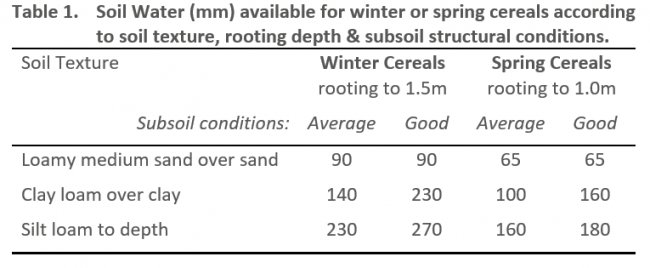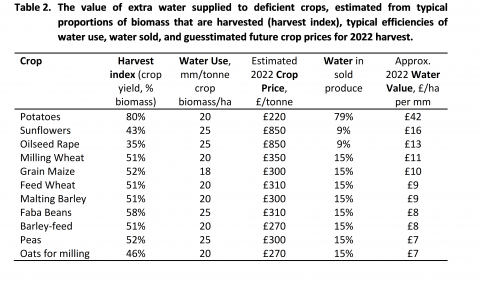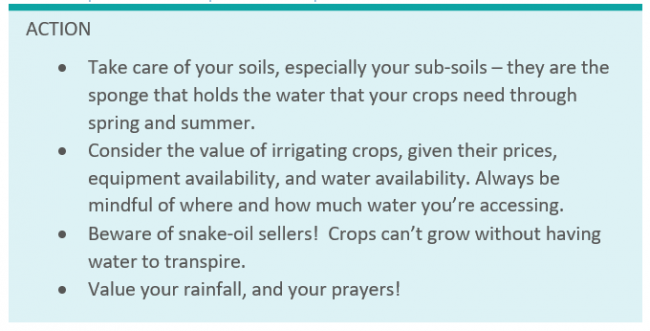Charlotte White & Roger Sylvester-Bradley

We are getting used to dry springs, but this one is more important than ever, because crop prices are higher than ever. Here we evaluate (in £s) the rain that you are praying for – or even the water that you are thinking of irrigating crop by crop, and we show the importance of each extra mm rain, or each extra centimetre of rooting depth, or each irrigated mm. Crops need water to grow. No water today – no growth today. Soils hold water that supplies crop growth every day, until it is exhausted, or until it rains. Luckily…
- All UK soils refill with water every winter (with very rare exceptions) right to the bottom (if you know where that is!)
- Sometimes it rains in summer!
The more that crops grow the more water they need; it’s proportional. Most crops have very similar demands for water – each bit of biomass they grow, they need about 200 times that in water. So, every 5 grammes of crop growth needs a litre, and every tonne per hectare needs 20 mm (or a bit more if they make oil instead of starch, or if they fix their own nitrogen).
With average sunshine, potential biomass growth through May, June, July, and August is about 20 tonnes, so 400 mm water is needed to support this. Of course, most crops cannot be kept fully green through all four months, but most farms would hope to maintain crops with full green canopies for around three of these months, so 300 mm is a more realistic target.
Very few farms can expect 300 mm rain through May to July or August, so the rest must come from somewhere, and without irrigation, it must be from the soil. Soils hold from 60 to 300 mm water per metre depth depending on texture. But whatever the soil, if roots go deep enough, crops will have plenty of water for high yields. We once had a crop of rye entered in the YEN competition, grown on a coarse sand with pebbles. It won! And we estimate that it did so by taking water all the way down to 3 metres and more!

Despite the current focus on topsoil health, it’s actually the subsoil that most affects the water supplies for crops. Not only rooting depth but subsoil structure is hugely important here (Table 1). Good, deep subsoils are essential to provide the resilience that farms need to sustain their crops through tricky years as well as through the occasional good year.
Weather data (see tables at the end of Crop Action) show that, across England, 2022 had the driest March since 2012, and now April has also been dry (rainfall ranged from 63% of average in the north to 38% in the east; see maps here) so we already have Soil Moisture Deficits (SMDs) of 50 mm in East Anglia. This means that some lighter soils have already lost much of their available water, which will be affecting your worries (and prayers!), depending on how much water you think your soils hold (see Table 1).
We don’t yet know whether this will be a good year but, with current events, we are pretty certain that crops will be more valuable this year than ever! So, it is probably worth reconsidering the value of supplying extra water to crops, whether by irrigation, deeper rooting or praying or dancing for rain! Table 2 shows the results of our calculations.

Potatoes are the arable crop most commonly irrigated. However, current global events and current price expectations, especially for oilseeds, are making their irrigation increasingly worthwhile, compared to potatoes.

